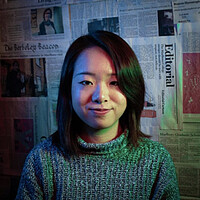To learn to skate, you must learn to get up again – even 10 years later
Loading...
My roommate and I sat very still and held our breath to watch the showdown between ice skaters Yuzuru Hanyu of Japan and Nathan Chen of the United States, as though our twitching or breathing might interfere with their programs at the Beijing Winter Olympics. But when Mr. Chen launched himself into the air, it wasn’t his quadruple flip that caught my eye – it was the empty seats in the upper deck behind him.
They looked familiar. And then I realized that the competition was being held in Beijing’s Capital Indoor Stadium. Those seats were where my parents had stood, my dad holding a video camera to record my daily practice sessions so we could review every twirl and spiral.
Born and raised in Beijing, I began skating when I was 8 years old. I remember the first time I stepped onto that rink; I glided forward cautiously, my toes pointed inward to keep me from falling.
Why We Wrote This
A child’s eagerness to live up to their parents’ expectations can become a burden too difficult to bear. But it’s a burden that can be lifted by love.
“Be bold!” my father shouted to me from that balcony. “Take a bigger step!” His stentorian voice echoed through the arena.
But as soon as I tried to do so, I lost my balance and fell – again and again. This is way harder than it appears, I recall thinking.
I’d seen Chinese pair skaters Shen Xue and Zhao Hongbo’s bronze medal-winning performance at the 2006 Winter Games in Turin, Italy. They inspired a wave of national pride and made figure skating a mainstream sport in China.
I joined the rush. Even as a young girl, I saw skating not only as a sport that combines athleticism and aesthetics, but also as my ticket to a top Beijing middle school. Even though my coach told me I’d started skating too late to get into elite competition, I was convinced that one day I would be just like the skaters I saw on TV.
The “kiss and cry” area for skaters at the Beijing Winter Olympics was where a broad hallway had been. Then, it was a place crowded with kids like me and their parents. The young skaters would be warming up before practice while their parents anxiously hoped their child would somehow rise to the top.
I spent most of my time outside school at the rink. There, my skating friends and I would laugh during our skating-backward races. There, too, I held back tears when my coach yelled at me for poor footwork. It’s where I stayed after my lessons to endlessly practice spirals and toe loop jumps.
Then one day, two intense years later, I’d had enough. The pressure was too much. I told my parents I couldn’t do it anymore.
Thankfully, my loving father and mother understood. They let me stop. But even after I quit, guilt and pressure stayed with me. My parents had sacrificed so much for me, and I felt I’d failed their expectations. I also felt I’d lost part of my identity; skating had set me apart. Could I hope to be considered for a top-notch school without it? I’d often had self-doubts, and this made it worse.
My fear of not getting into a competitive middle school was unfounded. For the next 10 years, though, I didn’t hear the grinding sounds of my skates biting into the ice. My after-school hours were packed with math and English tutoring. I started a new athletic endeavor – cross-country running – that I still pursue today. Most important, I was no longer forcing myself to do something that I didn’t feel in my heart.
Even so, I still enjoyed watching figure skating on TV from time to time. I admired the skaters’ hard work and achievement. They were living the dream I used to have.
Right before the pandemic lockdowns began, I returned home to Beijing over winter break from college in the U.S. In my closet I was surprised to find a shiny new pair of figure skates my dad had bought for me. The blades had been freshly sharpened.
“I figured you’d wear them eventually,” he said, confidently. “It’s just a matter of time.”
I shook my head. That thought had never crossed my mind. Still, I brought the skates back with me to Boston.
This winter, inspired by the Beijing Olympics, I put on skates again, the skates my father had bought for me. I carefully stepped onto the ice at a Boston rink. And this time, skating felt the way it had when I fell in love with it for the first time. I glided and danced on the ice, feeling free and joyful. I was skating without pressure, without winning or losing.
To learn to skate, one must get up after a fall. One cannot learn without falling sometimes – or often. I did fall again, but 10 years later I’ve finally gotten up again. I hear the echo of my father’s exhortation to me as a little girl:
“Be bold! Take a bigger step!”







